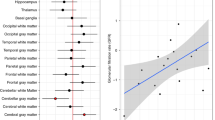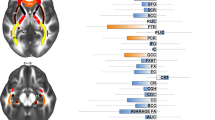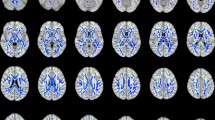Abstract
Background
Chronic kidney disease (CKD) is a risk factor for vascular disease and stroke. The spectrum of brain injury and microstructural white matter abnormalities in children with CKD is largely unknown.
Methods
Cross sectional study at two North American pediatric hospitals. A cohort of 49 children, 29 with CKD, including renal transplant (mean age 14.4 ± 2.9 years; range 9–18), and 20 healthy controls (mean age 13.7 ± 3.1 years; range 9–18) had their conventional brain magnetic resonance images (MRIs) reviewed by one neuroradiologist to determine the prevalence of brain injury. Fractional anisotropy (FA) maps calculated from diffusion tensor imaging (DTI) were generated to compare white matter microstructure in CKD compared to controls, using tract-based spatial statistics (TBSS).
Results
Focal and multifocal white matter injury was seen on brain MRI in 6 children with CKD (21%). Relative to controls, CKD subjects showed reduced white matter fractional anisotropy and increased mean diffusivity and radial diffusivity in the anterior limb of the internal capsule, suggestive of abnormal myelination.
Conclusion
Cerebral white matter abnormalities, including white matter injury, are under-recognized in pediatric CKD patients. Brain imaging studies through progression of CKD are needed to determine the timing of white matter injury and any potentially modifiable risk factors.
Similar content being viewed by others

Log in or create a free account to read this content
Gain free access to this article, as well as selected content from this journal and more on nature.com
or
References
Foley, R. N., Parfrey, P. S. & Sarnak, M. J. Epidemiology of cardiovascular disease in chronic renal disease. J. Am. Soc. Nephrol. 9(12 Suppl), S16–23 (1998).
Schnaper, H. W. et al. Cerebral cortical atrophy in pediatric patients with end-stage renal disease. Am. J. Kidney Dis. 2, 645–50 (1983).
Steinberg, A. et al. Computerized tomography of the brain in children with chronic renal failure. Int J. Pediatr. Nephrol. 6, 121–6 (1985).
Trompeter, R. S. et al. Neurological complications of arterial hypertension. Arch. Dis. Child 57, 913–7 (1982).
Gipson, D. S. et al. The nervous system and chronic kidney disease in children. Pediatr. Nephrol. 19, 832–9 (2004).
Gerson, A. C. et al. Neurocognitive outcomes in children with chronic kidney disease: current findings and contemporary endeavors. Ment. Retard Dev. Disabil. Res. Rev. 12, 208–15 (2006).
Gipson, D. S. et al. Memory and executive functions in pediatric chronic kidney disease. Child Neuropsychol. 12, 391–405 (2006).
Gipson, D. S. et al. The central nervous system in childhood chronic kidney disease. Pediatr. Nephrol. 22, 1703–10 (2007).
Icard, P. F. et al. The transition from childhood to adulthood with ESRD: educational and social challenges. Clin. Nephrol. 69, 1–7 (2008).
Tjaden, L. A. et al. Impact of renal replacement therapy in childhood on long-term socioprofessional outcomes: a 30-year follow-up study. J. Pediatr. 171(e1-2), 189–95 (2016).
Qvist, E. et al. Neurodevelopmental outcome in high-risk patients after renal transplantation in early childhood. Pediatr. Transplant. 6, 53–62 (2002).
Valanne, L. et al. Neuroradiologic findings in children with renal transplantation under 5 years of age. Pediatr. Transplant. 8, 44–51 (2004).
Moseley, M. E. et al. Diffusion-weighted MR imaging of anisotropic water diffusion in cat central nervous system. Radiology 176, 439–45 (1990).
Basser, P. J., Mattiello, J. & LeBihan, D. MR diffusion tensor spectroscopy and imaging. Biophys. J. 66, 259–67 (1994).
Fox, R. J. et al. A preliminary validation study of diffusion tensor imaging as a measure of functional brain injury. Arch. Neurol. 65, 1179–84 (2008).
Vaillancourt, D. E. et al. High-resolution diffusion tensor imaging in the substantia nigra of de novo Parkinson disease. Neurology 72, 1378–84 (2009).
McGraw, P. et al. Krabbe disease treated with hematopoietic stem cell transplantation: serial assessment of anisotropy measurements—initial experience. Radiology 236, 221–30 (2005).
Klawiter, E. C. et al. Radial diffusivity predicts demyelination in ex vivo multiple sclerosis spinal cords. Neuroimage 55, 1454–60 (2011).
Smith, S. M. et al. Advances in functional and structural MR image analysis and implementation as FSL. Neuroimage 23(Suppl 1), S208–19 (2004).
Andersson, JLR, M Jenkinson, and S Smith, Non-linear registration, aka spatial normalization, In: FMRIB Technical report TR07JA2 from www.fmrib.ox.ac.uk/analysis/techrep, 2007.
Smith, S. M. & Nichols, T. E. Threshold-free cluster enhancement: addressing problems of smoothing, threshold dependence and localisation in cluster inference. Neuroimage 44, 83–98 (2009).
Wakana, S. et al. Fiber tract-based atlas of human white matter anatomy. Radiology 230, 77–87 (2004).
Clayden, J. D. et al. Normative development of white matter tracts: similarities and differences in relation to age, gender, and intelligence. Cereb. Cortex, 22, 1738–47 (2012).
Bland, J. M. & Altman, D. G. Statistical methods for assessing agreement between two methods of clinical measurement. Lancet 1, 307–10 (1986).
Moodalbail, D. G. et al. Systematic review of structural and functional neuroimaging findings in children and adults with CKD. Clin. J. Am. Soc. Nephrol. 8, 1429–48 (2013).
Smith, J. M., Martz, K. & Blydt-Hansen, T. D. Pediatric kidney transplant practice patterns and outcome benchmarks, 1987-2010: a report of the North American Pediatric Renal Trials and Collaborative Studies. Pediatr. Transplant. 17, 149–57 (2013).
Gur, R. E. et al. Incidental findings in youths volunteering for brain MRI research. AJNR Am. J. Neuroradiol. 34, 2021–5 (2013).
Schunke, M. et al. Thieme atlas of anatomy: head and neuroanatomy. THIEME Atlas of Anatomy Series. 1, (414. Thieme, Stuttgart, 2010).
Zarei, M. et al. Two-dimensional population map of cortical connections in the human internal capsule. J. Magn. Reson Imaging 25, 48–54 (2007).
Sullivan, E. V. et al. Fiber tracking functionally distinct components of the internal capsule. Neuropsychologia 48, 4155–63 (2010).
Hooper, S. R. et al. Neurocognitive functioning of children and adolescents with mild-to-moderate chronic kidney disease. Clin. J. Am. Soc. Nephrol. 6, 1824–30 (2011).
Fennell, R. S. et al. A longitudinal study of the cognitive function of children with renal failure. Pediatr. Nephrol. 4, 11–5 (1990).
Levitt, J. J. et al. Fractional anisotropy and radial diffusivity: diffusion measures of white matter abnormalities in the anterior limb of the internal capsule in schizophrenia. Schizophr. Res 136, 55–62 (2012).
Smith, E. E. et al. Correlations between MRI white matter lesion location and executive function and episodic memory. Neurology 76, 1492–9 (2011).
Funding
This study was funded by the British Columbia Children’s Hospital Telethon Foundation Grant, by the Renal Research Institute at the University of North Carolina School of Medicine, and by NCTraCTS Institute at the University of North Carolina School of Medicine. Additional support for completion of the data analyses and for some of the data collected for this manuscript was provided by the Chronic Kidney Disease in children prospective cohort study (CKiD), with Principal Investigators at Children’s Mercy Hospital and the University of Missouri—Kansas City (Bradley Warady, MD) and Children’s Hospital of Philadelphia (Susan Furth, MD, Ph.D.). The CKiD Study is supported by grants from the National Institute of Diabetes and Digestive and Kidney Diseases, with additional funding from the Eunice Kennedy Shriver National Institute of Child Health and Human Development, and the National Heart, Lung, and Blood Institute (U01-DK-66143, U01-DK-66174, U01-DK-082194, and U01-DK-66116). The CKiD website is located at http://www.statepi.jhsph.edu/ckid. The funders of this study had no role in the study design, data collection or analysis, interpretation of data, or writing the report; or the decision to submit the report for publication.
Author information
Authors and Affiliations
Corresponding author
Ethics declarations
Conflict of interest
The authors declare that they have no conflict of interest.
Additional information
Publisher's note: Springer Nature remains neutral with regard to jurisdictional claims in published maps and institutional affiliations.
Electronic supplementary material
Rights and permissions
About this article
Cite this article
Matsuda-Abedini, M., Fitzpatrick, K., Harrell, W.R. et al. Brain abnormalities in children and adolescents with chronic kidney disease. Pediatr Res 84, 387–392 (2018). https://doi.org/10.1038/s41390-018-0037-5
Received:
Revised:
Accepted:
Published:
Issue date:
DOI: https://doi.org/10.1038/s41390-018-0037-5
This article is cited by
-
Diffusion tensor imaging of brain changes in patients with chronic kidney disease before cognitive impairment with 3 T MRI device
Egyptian Journal of Radiology and Nuclear Medicine (2024)
-
Neurodevelopmental profile of infants and toddlers awaiting a kidney transplant
Pediatric Nephrology (2024)
-
Prevalence of cognitive dysfunction and its risk factors in children with chronic kidney disease in a developing country
Pediatric Nephrology (2022)
-
Leveraging neuroimaging to understand the impact of chronic kidney disease on the brain
Pediatric Nephrology (2022)


